|
|
Parks in Vienna: Prater, Burggarten, Volksgarten etc.
The number of the sightseeings of Vienna is almost hard to cope with in some days of holiday time. One really has to decide previously which churches, museums, art exhibitions and, not to forget, which castles or palaces one wants to view. What one really notices by being on the spot is the abundance of parks and gardens in Vienna that, with their nicely arranged green areas, offer some lovely oasis to loaf on and relax. In total, we found more than 40 more or less largely arranged and more or less topically circumscribed parks in Vienna. Thus, there are historically arranged gardens, as for example those that are arranged all around the castle Schönbrunn or Belvedere. The largely arranged landscaped parks oftenly have different areas, in which one can either visit some restaurants or leisure centres, the way it is known in the famous prater. But with this page, we only want to present a small selection that we find worthwhile to visit during the visit of Vienna. Prater of Vienna with Big WheelWho does not know the Big Wheel of Vienna? Maybe it even belongs to the most famous big wheels of the world? Anyway, for Vienna, it is since more than 100 years one of the most important emblems and one of the attractions that every visitor wants to experience. The Prater-Big Wheel was for a long time one of the biggest big wheels of the world. Today, there are increasingly cities that built their own big wheels, as for example London. It is surely known afterwards if this is really worthwhile. We let our view travel widely over the roofs of Vienna and after this short experience we did not go home feeling necessarily more happy, but with an extended perspective over Vienna. 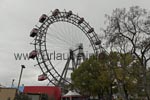
Unfortunately, it slightly rained during our visit and due to the autumn weather it was not really pleasant when the wind blew through the open wagon. Thus, it is recommendable to start an excursion to the prater either warmly dressed or with better weather conditions. But before accessing the actual big wheel, one can not only get informed on the spot about the history of origin and building of the big wheel, but also of the history of Vienna. In a kind of tent-stage, there are eight small big wheel wagons arranged in a circle on a spinning wooden floor. In caring precision work and with the small toy figures, some detailed coulisses and scenarios are imitated from the beginnings of Vienna with the Romans to important battles for Vienna up to the times of today. 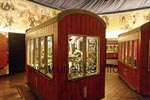
Before entering a gondola of the big wheel, one is first photographed so that one can buy his picture afterwards for a lot of money. But therefore, there is to queue; those who avoid this can go straight to the gondola. Once in the wagon, there is to wait until about 12 persons are collected there; then the big wheel spins for one gondola. In the big wheel of Vienna, things are not as it is the case in a fun fare or another festive fare, where one gets into the big wheel and it spins some rounds, but one does exactly one round there, not continuously but step by step. Thus, one gets upwards exactly one time and returns step by step down again. The wheel continuously spins one gondola further, so that people can get in and out. During my first visit in Vienna,this resulted to be a fate to me, as I already accessed the gondola in the early morning. It took an eternity until the people came so that I was in the air for nearly one hour. Thus, if there are too less visitors, the trip can be as unpleasant as if there is to queue as a result of too many visitors. 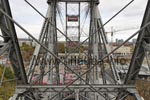
Thus, one slowly gets upwards in the gondola, and the view from the cabin gets increasingly better. While from the bottom, one still admires the construction of the Big Wheel, from the middle, one enjoys a fascinating view to the Prater. And the further one gets upwards, the better of course the views get to the city of Vienna and the surroundings.Upwards, people of course take a lot of pictures, as everybody wants to have a picture of himself in the cabin. By the way, the gondola has some bunches to sit on and relax; but most of the time, people prefer to stand and/or walking around in order to enjoy the panorama views. By this way, we had for example a free view to the St. Stephan's Cathedral , the Hundertwasser Powerhouse or the Danube Tower. Afterwards, all visitors were guided to the mentioned fotoshop and of course - how could it be different - led to a well arranged souvenir-shop, in which the big wheel was commercialised in any imaginable variants. No matter if t-shirts, dinnerware or sweets, those who still seek for a souvenir will surely find there one. Unfortunately, there is no possibility to avoid this shop, one willy-nilly has to walk through it. History of the Prater of ViennaThe area of the Prater of Vienna, a latin word that means "meadow", is in total approximately of 6.000.000 square metres and is located at the meadows of the Danube. By arriving with public means of transportation, one has to get off at the station Praterstern. From here, only a few minutes walk are needed until one arrives to the Prater. The Prater did not always have a significance of a fun fare. Still before the Prater was used as a hunting are by the imperial family in the year 1560, the area was in monstical and spiritual property. The publicity did not have a free access to it before the year 1766, when Joseph II. provided the Prater as local recreation also for the citizens of Vienna. With this opening, the trend of the Wurstelprater of Vienna developed, in which an increasing number of stands provided the character of a fun fare. No only the small themed environments like caroussels, swings, shooting galleries or ghost trains were originated like that but mainly also several restaurants and sausage stands. In this western part of the Prater of Vienna, there should be also space for the Big Wheel in the year 1898. 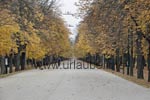
During the second world war, the whole area of the Prater of Vienna was strongly affected. The bombings destroyed main parts of the nature. What until then remained more or less untouched was finally destroyed by a fire in the year 1945. In a large-scaled citizens' initiative, the landscape was reforest. Even though some attractions of the Prater of Vienna still exist today, some clear modernizations catch one's eye. Numerous groups of visitors can feel like home in their Prater. Specially arranged jogging routes, skating rinks, or cross-country ski-tracks for the winter will make the hearts of sportemen miss a beat. Also the numerous playgrounds for children are suitable for excursions of some hours without spending too much money for each of the fun rides. But it is also possible to spend some hours in the Prater without any sportive relation. Only walking alongside the main avenue of more than 4 km length takes some time without having to take a branch-off. Each year in the spring time, the huge chestnut trees provide a high attendance when they are in full bloom. And those who prefer to do some passive sports can visit the football games of the football clubs of Vienna or some other sports events in the Prater stadion. Burggarten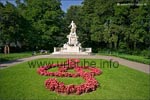
The Burggarten of Vienna is located right at the centre of the Ringstraße and it is very easy to get there by public means of traffic. Either one takes the subway no. U1,U4 up to Karlsplatz or the lines 1,2,D,J up to the station Opernring. Originally, the Burggarten was reserved for the private use of the imperial family up to the year 1918. At that time still sepatated by a wall from the Heldenplatz, the Burggarten is today accessible for everyone. The clear area is pervaded by narrow paths and one comes across to monuments of Mozart, the Emperor Franz and the Emperor Franz Joseph. The Palm House that is right adjacent to the Burggarten offers a beautiful coulisse for having a walk. Here, one can look at 50 different kinds of butterflies in an imitated mini-natural world. A stylish highlight is the café in the interior of the Palm House, that is a restautant, bar and longue at the same time. Volksgarten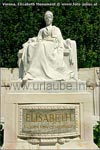
The Volksgarten is also located at the Ringstraße amidst the centre of Vienn and is located between the Heldenplatz, Burgtheater and Ballhausplatz. It was originated betqeen 1819 and 1823 and was therewith part of a trend that became modern in the whole of Germany. 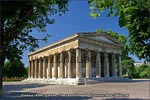
With the Volksgärten (urban parks) paid with public money, the general population was supposed to get the possibility to relax and educate themselves. Still today it is possible to see there famous monuments likefor example the one of the Empress Elisabeth or the one of Franz Grillparzer. The imitation of the Greek Theseion, the antique temple of Athens, is specially impressive. But the park unfolds its real beauty in spring and summer time, when the flower beds turn to widely extended flower seas. City Park of ViennaThe City Park of Vienna is, with an area of 65.000 m², a complex that is very oftenly visited, either by tourists as also by local people. With its opening date in August 1862, it is even the first public park of Vienna.. 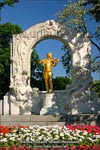
Its location at the Wien, a small river that flows from the Wienerwald and disembogues at the Urania at the east of the city centre of Vienna in the Danube channel, is specially nice. The whole park complex has a charm of its own. There are nostalgic bunches everywhere that are positioned in apparently endless lines alongside the beautifully arranged paths. The ducks and pigeons are very tame and also very curious during their search for food. 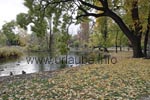
What is rather annoying is the rush that one in all probability will come across to in front of one of the most popular photo motifs of Vienna: the golden shining monument of Johann Strauß tht was positioned in the year 1921 close to the Kursalon. But Strauss is not the only composer of Vienna one comes across to during the walk through the city prk. Here, there are lso the monuments of Schubert, Bruckner or other painters of Vienna. The city park is located a little outside the centre of Vienna, but it is very easy to get there by public means of traffic. With the line U3 up to the station Stubentor, with the line U4 up to Stadtpark. Also the trams no. O,1 and 2 go straight there. We visited the city park of Vienna in the very early morning when the crowds of tourists at the composers' monuments were still moderate. By this way, we could walk unhurriedly through the city park and then have a cozy typical breakfast in a big café tight in the park. 
Copyright 2007-2008: Patrick Wagner, www.tourist-guide.biz |
||